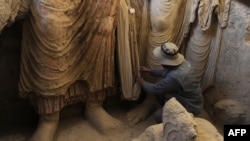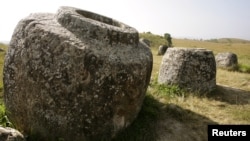The preservation watchdog Global Heritage Fund recently released a list of Asia's 10 most significant archaeological and heritage sites that are under threat, including sites in two of RFE/RL's broadcast countries -- Afghanistan and Pakistan.
As the report notes, the sites should be preserved not only for their historic significance but also for the roles they can play in helping impoverished nations economically:
The ancient Buddhist monastery complex -- some 4,000 hectares worth -- sits atop vast copper reserves outside the capital, Kabul. The China Metallurgical Group Corp. has agreed to give archaeologists three years to excavate the site before it is destroyed to make way for what would be the world's second-largest copper mine.
As RFE/RL correspondent Frud Bezhan noted in an article about the site in February:
This complex of ruins, the report notes, includes a Mesolithic cave, four settlement sites, Buddhist monasteries, and medieval Muslim mosques and madrasahs. It is threatened by insufficient management, nearby quarrying and stone-blasting, looting, and militant attacks.
PHOTO GALLERY: Asian heritage sites under threat
Noted for its tall conical towers, Ayutthaya was founded in 1350 and was one of the most important economic and trade centers of the region. It was destroyed by the Burmese Army in 1767. It's threatened by persistent flooding and poor management.
A defensive fortress built into the walls of Santiago, Intramuros was constructed by Spanish conquistador Miguel Lopez de Legazpi and the 16th century. Severely damaged during World War II, its current threats include modernization, development pressures, and insufficient management.
Global Heritage calls Kashgar -- on China's western border with Afghanistan and Pakistan -- one of the world's best-preserved examples of a traditional Islamic city. It's home to China's largest mosque. Kashgar is under threat from aggressive urban development and what Global Heritage calls "destructive modernization."
The oldest archaeological site ever found in Bangladesh, Mahasthangarh dates back to the 3rd century B.C. Many of the mounds surrounding the great citadel have not yet been excavated but are believed to contain Hindu temples and treasures. It's threatened by poor management, looting and vandalism, and development pressures.
Myauk-U contains some 200 Buddhist monuments --pagodas, temples, monasteries, and stupa -- dating to the 15th and 16th centuries and was an important regional trade hub as part of the Arakenese kingdom. It's threatened by the construction of a new railroad through the area, as well as flooding and insufficient management.
Thousands of massive megalithic stone "jars" -- made from sandstone, granite, and limestone -- litter the Xieng Khouang Plateau. They are believed to be part of the funerary customs of Iron Age inhabitants. The site is threatened by unexploded ordnance from the Second Indochina War, as well as poor management and development pressures, including use of the jars by farmers for animal troughs and chicken coops.
The 11th-century Khmer temple is located atop a massive cliff -- "perhaps the most stunning setting of all Khmer temples." It was modified by successive kings of the empire and reveals the hallmarks of several architectural styles. It is threatened by military skirmishes between Cambodia and Thailand, which also claims ownership of the site, as well as natural disasters, due to its vulnerable location.
Home to the great Indus civilization more than 5,000 years ago, the site includes evidence of paved roads, drainage systems, and advanced metal working. Much of the site, consisting of ancient mounds as high as 15 meters, has not been excavated. The site was abandoned and plowed under in 2004 and is used now for drying and harvesting buffalo dung. Looting is also a problem.
As the report notes, the sites should be preserved not only for their historic significance but also for the roles they can play in helping impoverished nations economically:
Each of the 10 sites documented in Asia's Heritage in Peril represents a vast, untapped economic opportunity for its host nation and local communities in need. International and domestic tourism to major archaeological and heritage sites has soared over the past 10 years: From $8 billion to over $25 billion in annual revenues, according to the Vanishing report.
By 2025, GHF estimates that global heritage sites in the worldʼs poorest countries will generate over $100 billion annually, while creating millions of new jobs and business opportunities — but only if current trends of loss and destruction are reversed.
By 2025, GHF estimates that global heritage sites in the worldʼs poorest countries will generate over $100 billion annually, while creating millions of new jobs and business opportunities — but only if current trends of loss and destruction are reversed.
The sites (listed below) are under threat, Global Heritage says, due to factors such as development pressures, unsustainable tourism, insufficient management, looting, and war and conflict.
MES AYNAK, Afghanistan
The ancient Buddhist monastery complex -- some 4,000 hectares worth -- sits atop vast copper reserves outside the capital, Kabul. The China Metallurgical Group Corp. has agreed to give archaeologists three years to excavate the site before it is destroyed to make way for what would be the world's second-largest copper mine.
As RFE/RL correspondent Frud Bezhan noted in an article about the site in February:
Mes Aynak, meaning "little copper well," was the center of a Buddhist Kingdom before Islam came to Afghanistan. It is thought that monks settled here for its ample supply of copper, which brought them great wealth and allowed them to build a grand monastery.
But if copper led to the creation of the settlement, it appears now that it will also lead to its destruction.
But if copper led to the creation of the settlement, it appears now that it will also lead to its destruction.
TAXILA, Pakistan
This complex of ruins, the report notes, includes a Mesolithic cave, four settlement sites, Buddhist monasteries, and medieval Muslim mosques and madrasahs. It is threatened by insufficient management, nearby quarrying and stone-blasting, looting, and militant attacks.
PHOTO GALLERY: Asian heritage sites under threat
AYUTTHAYA, Thailand
Noted for its tall conical towers, Ayutthaya was founded in 1350 and was one of the most important economic and trade centers of the region. It was destroyed by the Burmese Army in 1767. It's threatened by persistent flooding and poor management.
FORT SANTIAGO AND INTRAMUROS, Philippines
A defensive fortress built into the walls of Santiago, Intramuros was constructed by Spanish conquistador Miguel Lopez de Legazpi and the 16th century. Severely damaged during World War II, its current threats include modernization, development pressures, and insufficient management.
KASHGAR, China
Global Heritage calls Kashgar -- on China's western border with Afghanistan and Pakistan -- one of the world's best-preserved examples of a traditional Islamic city. It's home to China's largest mosque. Kashgar is under threat from aggressive urban development and what Global Heritage calls "destructive modernization."
MAHASTHANGARH, Bangladesh
The oldest archaeological site ever found in Bangladesh, Mahasthangarh dates back to the 3rd century B.C. Many of the mounds surrounding the great citadel have not yet been excavated but are believed to contain Hindu temples and treasures. It's threatened by poor management, looting and vandalism, and development pressures.
MYAUK-U, Myanmar
Myauk-U contains some 200 Buddhist monuments --pagodas, temples, monasteries, and stupa -- dating to the 15th and 16th centuries and was an important regional trade hub as part of the Arakenese kingdom. It's threatened by the construction of a new railroad through the area, as well as flooding and insufficient management.
PLAIN OF JARS, Laos
Thousands of massive megalithic stone "jars" -- made from sandstone, granite, and limestone -- litter the Xieng Khouang Plateau. They are believed to be part of the funerary customs of Iron Age inhabitants. The site is threatened by unexploded ordnance from the Second Indochina War, as well as poor management and development pressures, including use of the jars by farmers for animal troughs and chicken coops.
PREAH VIHEAR, Cambodia
The 11th-century Khmer temple is located atop a massive cliff -- "perhaps the most stunning setting of all Khmer temples." It was modified by successive kings of the empire and reveals the hallmarks of several architectural styles. It is threatened by military skirmishes between Cambodia and Thailand, which also claims ownership of the site, as well as natural disasters, due to its vulnerable location.
RAKHIGARHI, India
Home to the great Indus civilization more than 5,000 years ago, the site includes evidence of paved roads, drainage systems, and advanced metal working. Much of the site, consisting of ancient mounds as high as 15 meters, has not been excavated. The site was abandoned and plowed under in 2004 and is used now for drying and harvesting buffalo dung. Looting is also a problem.






